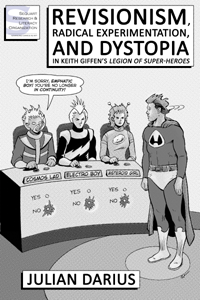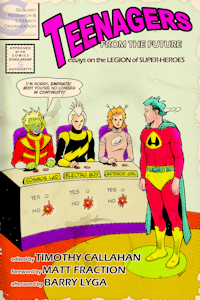We previously introduced Invasion and discussed its first issue. Today, we continue with issue #2.
By the time Invasion #2 (titled “Battleground Earth”) begins, Superman has successfully negotiated a 24-hour cease-fire with the Dominators. Many heroes, fresh off their encounters with aliens in the tie-ins, have assembled to coordinate strategy. Captain Atom, a hero created by the U.S. government, has been placed in charge. Amanda Waller, head of the government-run Suicide Squad (a program that sends captured super-villains on dangerous missions), informs the heroes that she’ll now be enlisting super-villains as never before. Great menaces make for strange bedfellows, and war often requires moral compromises.
In fact, Superman has negotiated the cease-fire under false pretenses, claiming that Earth needs time deliver its super-heroes. The heroes then proceed to break the cease-fire, as Superman leads a squad of heroes in an assault on occupied Australia. Meanwhile, Aquaman, the Doom Patrol, and the Sea Devils resume their assault on the Gil’Dishpan beneath the Arctic. The Suicide Squad engages Khunds in the South Pacific. Flash and Manhunter engage shape-shifting Durlans in Cuba, where Flash’s father dies detonating a bomb in Havana’s harbor that takes out the boat that functions as the Durlans’ headquarters. The New Guardians continue battling Okaarans in Russia. Even Lex Luthor gets into the act, creating a bomb in the form of the Flash, which explodes on board a Dominator ship. It was all great drama, and not without a certain amount of poetics: a shot of Moscow burning carried the simple caption “Moscow… / … does believe in tears.”
In Australia, the newly super-powered Daxamites decide to cease simply observing and attack Superman, but they fall ill due to some element in Earth’s atmosphere. Instead of letting them die, Superman pulls them out into space, thereby winning their loyalty. One Daxamite soon descends back to Earth, dying in order to transmit a message to his home planet.
With the war turning Earth’s way on all fronts, Captain Atom orders a strike on the aliens’ ships orbiting Earth. The Daxamites joins the Justice League and Firestorm to battle the aliens on the moon. A riot breaks out in Starlag, organized by new character Vril Dox of Colu.
In response to the signal sent from Earth, the Daxamite fleet arrives. It signals that it sides with Earth. The Daxamites all have Superman-like powers here, and they pour into space en masse, where they’re joined by the super-heroes who were on the moon. In short order, the alliance fleet is decimated. On the planet below, the aliens are forced to retreat on every front. A high-ranking Dominator issues a statement implying the Dominators have a secret plan to use super-powered humans as weapons. In response, the alliance (which has shown signs of tensions all along) breaks up, and most of the species surrender to the Daxamite fleet.
The Dominator leader is now forced to choose between surrender and annihilating Earth. He’s going to destroy the planet until he inexplicably changes his mind and signals surrender instead. An outraged Khund leader kills the Dominators present and prepares to destroy Earth anyway – but instead commits suicide by shooting himself in the head. Deadman, a magical hero with the ability to possess people, now reveals himself to readers. In addition to causing the Khund’s suicide, he also caused the Dominator leader to signal surrender, instead of destroying the planet. Based on the other Dominators’ protests, we can also guess that Deadman also caused the transmission about the Dominators’ duplicity that broke up the alliance.
The invasion was over.
A TV report ends the issue, and it conveys that humans around the entire planet feel relief. One gets the sense that any human being living in the DC Universe will remember these historic events. Readers are shown images of victory and aliens withdrawing on the war’s various fronts. Captain Atom announces the plan for the aliens’ withdrawal to the United Nations, thanking the Daxamites and calling for the nations of the world to continue cooperating. “Perhaps we can finally unite to bring about a lasting world peace,” he says.
Here, as with the earlier usage of the U.N., it’s important to remember the context of the Cold War. The Soviet Union was still seen as a threat, and American schoolchildren were still being raised to believe their lives would most likely end in nuclear fire. There was broad acceptance of the manifest need for “a lasting world peace,” in which diplomacy and the United Nations would have to play a critical role.
This same context produced Watchmen, which ends with the world’s nations uniting, at least temporarily, in the wake of what they mistakenly believe to be an alien attack upon New York City. Despite Watchmen’s many subtle and complex characters, its conclusion presents a rather rosy view of humanity. It’s hard to believe that all nations would even accept the claim of extraterrestrial involvement.
Invasion doesn’t have quite as rosy a view of humanity. Here, there can be no doubt about the reality of the extraterrestrial invasion, and the entire world shares the resulting scars, not simply New York City. The penultimate page, as the reporter poetically sums up the devastation around the world, makes this perfectly clear. We’re told and shown the immense devastation in Australia, fire raging in Havana’s harbor, “hunger and disease” in the ruins of Moscow, and Pacific islands that have been turned from “paradises” into something better resembling “the aftermath of Nagasaki.” This allusion to the second Japanese city destroyed by a U.S. atomic bomb during World War II reinforces the very real-world tensions for which the story may be seen as a metaphor – the same tensions Watchmen was in some sense about.
The reporter then outlines celebrations for Earth’s super-heroes around the world. But in the issue’s final panel, he shifts abruptly: “In other news, the tiny gulf state of Bialya – taking advantage of the confusion – has invaded the neighboring nation of Koonish. / Some things, it seems, never change.” True, no real-world nation is referenced here; Bialya is a corrupt, fictional nation that Giffen used repeatedly in his Justice League International. But it’s a nice final twist nonetheless – as well as a warning that all of this celebration in the wake of Earth’s liberation hasn’t changed human nature or international politics overnight.
With this, the story of Invasion would seem to be concluded. This came as a surprise to many readers at the time, who expected the alien invasion to be repelled only in the third and final issue. This is certainly an odd structure, especially for a universe-wide crossover, a form that tends to resolve the main concflict only in the final issue, with little room for dénoument.
That said, Invasion #2 doesn’t feel especially rushed on its own terms, despite its vast scope. For those who read the previous month’s tie-ins, however, the mini-series only had a few pages to resolve battles in multiple settings that had already been given their own full issues. In Invasion #2, many characters continued fighting in the same locales and against the same foes as in their own titles, and this could produce a sense of imbalance. These battles’ first acts (prior to the cease-fire) were given considerable space in the tie-ins, only for their climactic second act to occur mostly off-panel and through short vignettes in Invasion #2. This doesn’t lessen that issue itself, which works rather well despite its scope. But it does lessen the larger crossover.
It should be pointed out, however, that this is a necessary byproduct of Invasion’s structure. The first month of tie-ins flow out of Invasion #1 and into Invasion #2, with no significant overlap, helping the event as a whole feel clean and easily comprehensible – a rare achievement in universe-wide crossovers. The downside of this, however, is that all those tie-ins have to be resolved in a single issue of the mini-series. Thankfully, that issue is 80 pages; it’s hard to imagine how much more extreme this effect would be, were Invasion #2 forced to be condensed into 40. Invasion #2 does an excellent job of following up on the tie-ins without requiring readers to have read them. Everything’s remarkably clear to those who only read the mini-series. But there’s no way Invasion #2 can satisfy readers of all of these titles, who might like to see more of what their heroes did to actually repel the invasion, not merely to fight the “First Strike!” against the invaders.
Invasion #2 beneits from Giffen penciling the second half of the issue. Todd McFarlane, who penciled (over Giffen’s rough breakdowns) the first issue and the first half of this one, would soon become a superstar artist through his work on Marvel’s Spider-Man. He certainly does a good job here, and his expressive, energetic style helps sell the story’s super-heroic drama. But Giffen’s detailed style is perfect for the alien fleets in the second half. As soon as Giffen’s penciled pages begin, every console on every alien ship is filled with lines suggesting intricate technology. One of the real joys of the story’s climax is seeing the detail Giffen brings to entire fleets of alien ships, which appear to be composed of intersecting, overlapping, textured volumes that feel like what a spaceship might look like, even if we can’t identify what every portion of the design is for.
Giffen also excels here at faces, and while that’s true of human expressions, it’s especially effective here for the alien commanders whose actions drive the resolution. The faces of the Dominators take on a lot more crinkles, to the point that they sometimes feel sculpted, and consequently look a lot more alien and menacing.
.































































